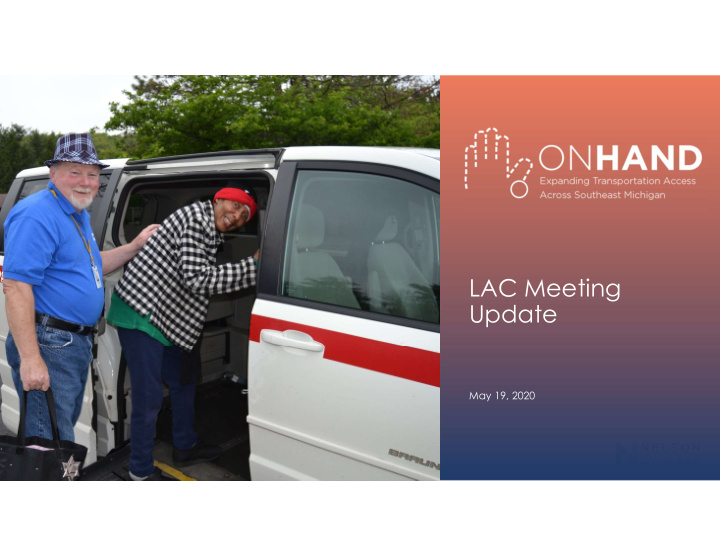



LAC Meeting Update May 19, 2020 1
COORDINATED HUMAN SERVICE PUBLIC TRANSIT PLAN Project Objectives • Understand specific needs associated with target populations o Older adults o Persons with disabilities o Individuals with low incomes • Develop a framework to strengthen existing coordination efforts • Use process that is consistent with the federal requirements How can the SE Michigan Transit Partners provide mobility options for seniors, people with disabilities, and people with low incomes that are also cost efficient for the region? 2
PROJECT STATUS
PROJECT STATUS • Technical Analysis is Winding Down o Market Analysis o Provider Inventory o Funding Inventory o 5310 Program Management Plan • Outreach o Regularly scheduled Technical Working Group Meetings o Stakeholder interviews o Survey 4
5
MARKET ANALYSIS
7
8
MARKET ANALYSIS Findings and Insights for On Hand • Stable growth but continued sprawl o Loss in urban core to suburban and rural fringe o Harder to serve efficiently with demand response service • Highest need communit ies in Wayne County and City of Detroit o Followed by southern portions of Macomb and Oakland County • Most vulnerable populations also greatest in Wayne County o High needs in urbanized areas, but also in rural communities – W WASHTENAW 9
PROVIDER INVENTORY
TRANSPORTATION SERVICE INVENTORY
MUNICIPAL DEMAND RESPONSE SYSTEMS 12
MUNICIPAL DEMAND RESPONSE SYSTEMS - COLLABORATIONS Note: Only collaborations shown; see municipally sponsored demand response services for complete network 13
SMART SHUTTLE AND DIAL-A-RIDE 14
WEEKDAY DEMAND RESPONSE SERVICE 15
DEMAND RESPONSE SERVICE AFTER 6:00 PM 16
DEMAND RESPONSE SERVICE SATURDAYS 17
TRANSPORTATION SERVICE PROVIDER INVENTORY Key Findings • Good service area coverage o Detroit’s coverage provided by ADA paratransit o Fixed route networks have coverage-based approach o Ann Arbor coverage includes after hours services • Resources and technical assistance through SMART o Funding, vehicles and technical assistance o Results in a strong local network of service • Local examples of regional coordination o Especially in Macomb and Oakland Counties
FUNDING INVENTORY
FUNDING INVENTORY • Federal Transit Administration (FTA) o Transit funds (5311, 5307, 5339) o Older adults and people with disabilities (5310) • Non-DOT Federal funds o Department of Health and Human Services • Michigan DOT o Local bus operating and capital o Specialized services • Regional funds / Property Tax • Local funds o General revenue contributions o Municipal credits • Other (fares, partnerships, etc.)
FUNDING INVENTORY Key Findings • All providers rely on multiple funding sources to operate o Loss of one source could end service o Assembling multiple grants is complicated o Different coordination models Coordinated operations Coordinated service delivery and operations Differences reflect funding programs, relationships between communities, and provider organizational models.
FUNDING INVENTORY Key Findings Transit Funding Programs • Funding streams designed with similar goals in mind • 5310 • MDOT Specialized Transportation • Grant requirements, controls or reporting limited • SMART Community and not well coordinated Transportation • General Fund revenues • Municipal credits • Performance data and service “value” not consistently captured, especially for municipal programs
USER SURVEY
USER SURVEY Status Update • Survey closed on February 28, 2020 • Completed surveys rolling in until March 13, 2020 o Expect about 1,000 completed surveys o Good representation from individuals with disabilities, older adults and minority populations • Draft Findings available late March
PRIORITIZATION EXERCISE
NEEDS AND GAPS Exercise • Rate potential needs and gaps according to scale provided o Not constrained – can all be high or can be all low o Be prepared to discuss 1 or 2 topics where need is highest and lowest If needed, explain your interpretation/definition of need or gap • Prioritization Area of struggle – top priority 1. Needs help and important, but not highest priority 2. Doing okay, needs improvement but working 3. Not a priority right now 4. 26
1, Area of struggle – top priority 3. Doing okay, needs improvement but working 2. Needs help and important, but not highest priority 4. Not a priority right now Regional connections (across Improve infrastructure (make it Information about existing jurisdiction boundaries) easier to use transit) services (service use and productivity) Increasing service (longer hours or Funding (for municipal and human Consumer information about more days of service) service transportation providers) existing services Coordination among providers Improving technologies used Maintaining vehicles and (ADA eligibility, purchase of service, by Transportation Providers equipment vehicle sharing) 27
THANK YOU! Bill Schwartz 857.305.8012 bschwartz@nelsonnygaard.com
Recommend
More recommend